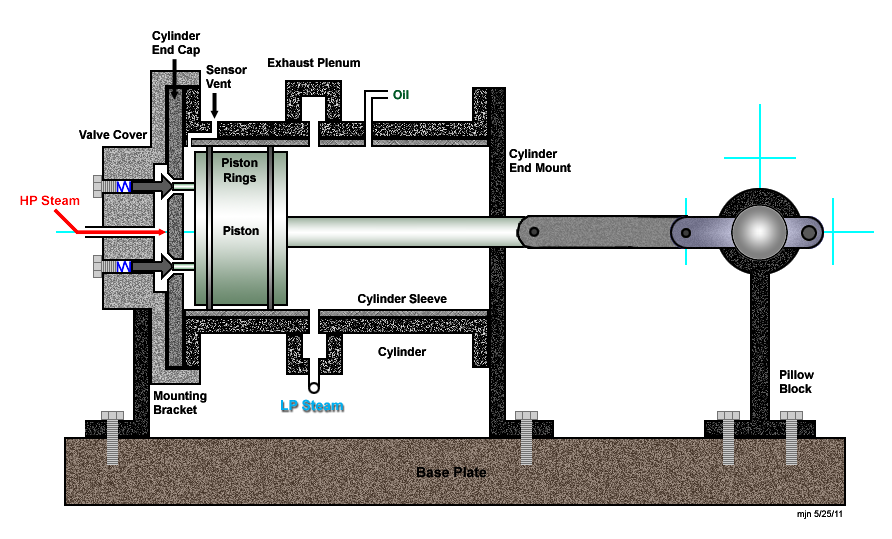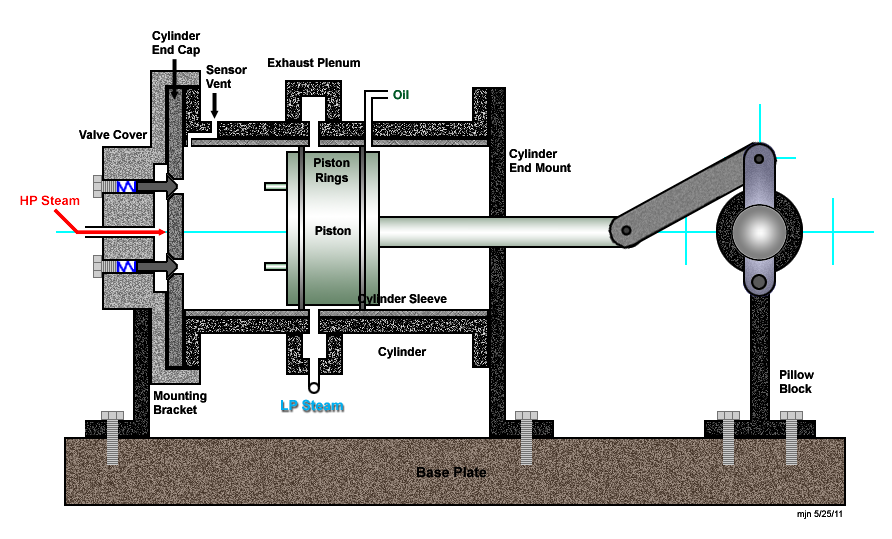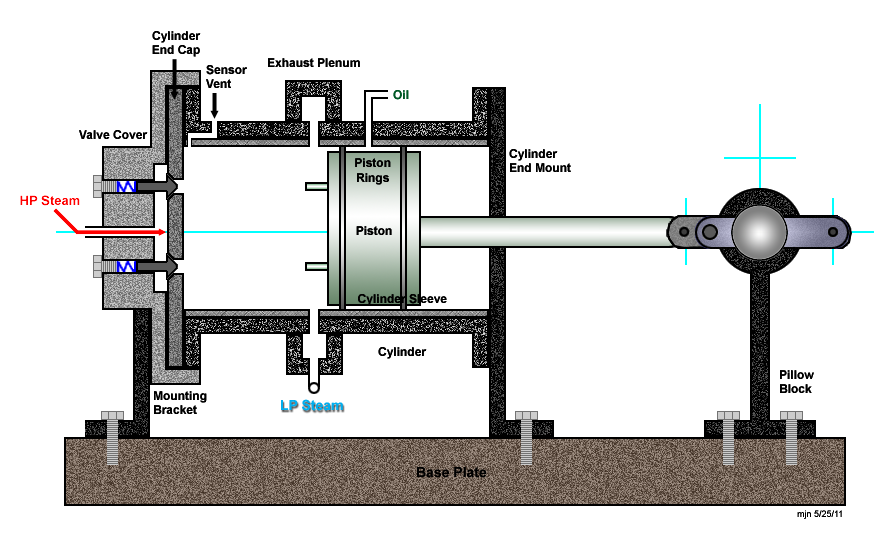Steam Engine Design
Jump to navigation
Jump to search
Main > Energy > Steam Engine
This page will be used to describe the OSE Open Source Steam Engine design, design issues, and completed drawings.
See bump valve prior art - http://www.rossen.ch/solar/wcengine.html
See also:
- Existing and Historic Designs
- Other Engine Designs
- Steam Generator Designs
Bump Valve Engine Design
Three points in the steam cycle are shown.
Design Updates:
- 5/2/11 - Rev. 2: Initial bump valve design.
- 5/6/11 - Rev. 3: Added flange on crankshaft end of cylinder and exhaust plenum.
- 5/10/11 - Rev. 4: Improved bump valve added, cylinder liner is now thick.
- 5/11/11 - Rev. 5: Added mount brackets, pillow block, extended piston stem.
- 5/25/11 - Rev. 6: Widened cylinder flanges, dropped water vent, added sensor vent, cylinder liner to scale.
1. Steam Fires
2. Steam Expands
3. Steam Vents
Description
This is a single-action uniflow steam engine that uses a bump valve to admit steam and an exhaust vent to emit cooled steam.
Design Features:
- Simple design with a mix of fabricated and off-the-shelf parts.
- Modular and stackable - cylinders can be ganged together to increase power.
- Easy assembly - minimal welding
- Repairable - comes apart for cleaning, maintenance, and repair.
- Easy fabrication - lathing, milling, cutting, and drilling.
- Self-lubricating - oil sprays.
- Crank shaft can be configured for multiple cylinders.
Sub-assembly Designs:
- Steam Engine Design/Bump Valve
- Steam Engine Design/Cylinder
- Steam Engine Design/Crank Shaft
- Steam Engine Design/Piston
- Steam Engine Design/Lubrication
- Steam Engine Design/Exhaust
Alternative Designs:
Review Notes
Tom Kimmel of SACA
Some observations and recommendations from Tom:
- Do more research.
- Come to my shop and look at real steam engines.
- Add teeth to the flywheel to allow an electric starter motor.
- Cylinder liners (sleeve) should be cast iron. Look into motor rebuild kits.
- Valves are not "chinese hat". Talk to Jay Carr about his design.
- Open or closed crank is a choice. Not critical.
- Lubrication is important, but had no specific recommendations.
- Start with conservative materials (like iron) and consider advanced materials later (like nitride coatings).
- Consider designing an exhaust manifold from the start.
- Visit Bill Ryan north of Chicago who has experience with making bash valves.
- Don't use stainless steel as a cylinder line.
- Consider 12v electric system for fans, solenoids, relays, water level sensors, and starter motor.
Ken Helmick of SACA
Some observations and recommendations from Ken:
- Initial decisions having huge influence on final design.
- Higher operating pressures and temperatures lead to potentially higher efficiency.
- A uniflow engine has the potential of higher efficiency.
- A counterflow engine has the relative advantage of being more easily operated.
- Wrapping a sleeve and welding is not likely to yield a satisfactory engine
- To make a sleeve, consider:
- Cast it using a sand mold.
- Use off-the-shelf sleeves.
- Purchase already honed hydraulic cylinder tubes.
- Convert an existing IC engine or extensively utilize IC engine components.
- If welding is employed, stress-relieve the assembly and then re-hone lightly in case of any slight thermal induced distortion to the bore.
- Valve springs must be wound from superalloys and heat treated. Conventional springs will fail from the heat of the steam.
- Bump valve engines probably are more efficient at some moderate rpm.
- An alternative to bump valves is a smaller piston valve mounted coaxially with, and upon, the engine piston.
- Always enclose the crankcase of any higher rpm engine.
- There is an incredible variety of piston rings available in almost any size, configuration and material imaginable and this is about the last reason I would select a given engine diameter.
- Electric starter motors are simple. Older General Motors alternators are widely available and they have an integral voltage regulator.
- A uniflow exhaust manifold could be very, very simple, depending on the cylinder.
- The crankshaft is the heart of the engine.
- The average home machinist is typically not equipped for (nor capable of) building a multiple throw, one piece crankshaft.
- One route to consider is the built-up crank.
- If a one piece crank is desired, the best route to go would be to either cast a rough out of a high grade of iron.
- The home machinist can balance a crank with a single throw but multiple pin cranks can only be balanced in a shop with a dynamic balancing machine.



